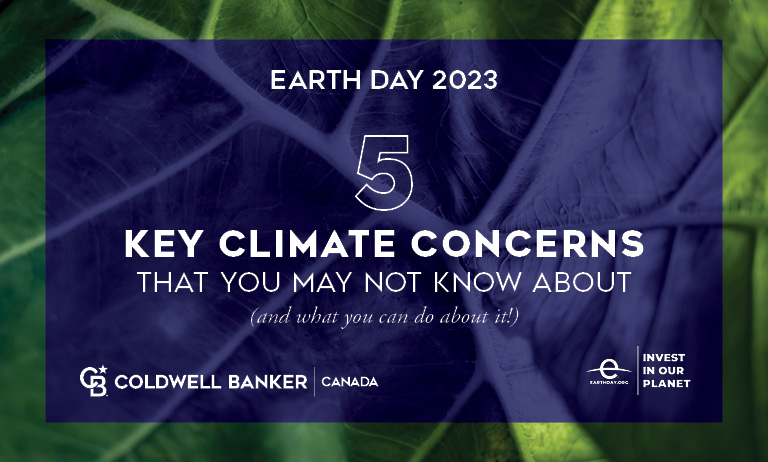Earth Day is the annual global event happening this Saturday, April 22, 2023. The theme for this year is “Invest In Our Planet”, in hopes to brings attention to the importance of dedicating time, energy, and resources to proactively help solve climate change and other environmental issues.
We talk a lot about our homes, whether we’re buying, selling, renovating, or just living in, and Home is the heart of our core values and our lives. For Earth Day this year, it’s time to talk about everyone’s home: Earth.
Here’s a list of 5 key climate concerns that impact us all, and a few things you can do about it!
1. Thawing Permafrost
- What it is: Covering 24% of the surface of the land mass in the northern hemisphere, the 9 million square miles of permafrost (thick subsurface soil layer frozen year-round) holds up to 1,600 gigatons of carbon, nearly double what exists in the atmosphere.
In a nutshell, the permafrost is heating up faster than expected, causing a significantly higher amount of greenhouse gases to be released which speeds up global warming, thus further feeding into the accelerated cycle to thaw/release. As the ground thaws, ice melts and alters the landscape creating pockets where water sits. That water speeds up thawing further, causing the land to shift which then releases the long-stored pockets of carbon. The carbon gets released as carbon dioxide and methane, which is 25 times more potent than CO2. Methane is responsible for around 30% of the rise in temperature and contributes to the spread of Arctic wildfires with devastating effects, adding to the positive feedback loop. The Arctic is warming up annually at more than twice the rate of the rest of the planet, allowing this release of gases to happen year-round as opposed to in the few summer months of previous years. Warmer temperatures also lead to less snow over winters, creating a darker landscape that absorbs rather than reflects the sun’s rays, resulting in further heating of the land.
Greenhouse gases absorb and retain solar energy in our atmosphere, causing the “greenhouse effect” or the heating of our planet. According to National Geographic, “From the unexpected speed of Arctic warming and the troubling ways that meltwater moves through polar landscapes, researchers now suspect that for every one degree Celsius rise in Earth’s average temperature, permafrost may release the equivalent of four to six years’ worth of coal, oil, and natural gas emissions—double to triple what scientists thought a few years ago.”
- Why it matters: The thawing of permafrost was not taken into account in previous climate models, meaning that climate change is happening faster than expected and that current plans to curb emissions are not sufficient as once thought. The more carbon that’s released into the atmosphere, the faster the effects accelerate. The results effect all of us, from warming temperatures, unpredictable and devastating weather events, to rising sea levels, habitat and food source loss for animals, among a multitude of other things.
- What you can do: This is challenging to solve as scientists are unsure how to tackle this issue at the scale and rate that is required but there are still ways you can make a change. You can lobby for policy change to cut emissions at a more efficient rate. Consider your reliance on fossil fuels not only by driving less, but also it’s use in powering electricity, and think about our desire and demand for products, much of which is manufactured with the use of fossil fuels (not to mention less pollution or the energy and resources used in shipping). Explore switching to alternative energy sources, and give thought to purchasing less.
2. Monoculture Lawns & Landscaping
- What it is: Monoculture lawns or landscapes are areas that have been developed to contain only one or a few types of species. While relatively new, it’s now hard to imagine our homes and cities without them. Modern lawns as we know them were developed in the 1860’s and have only been common-place since the 1950’s.
- Why it matters: When there’s a lack of diversity in an ecosystem, it is left vulnerable to disease and invasive species, while providing very little nutrition or shelter for pollinators, insects, or birds. Maintenance requires hundreds of litres of water, and use of chemical pollutants and gasoline. Gas powered mowers emit 11 times more air pollution than a new car for every hour of operation and two-stroke engines such as those used in hedge trimmers are notoriously inefficient.
- What you can do: Leave clippings on your lawn and mow as little as possible, an ideal amount being once every two – three weeks. Consider replacing your lawn with a permaculture of a variety of native plants including flowers and different grasses. This helps to create more nitrogen-rich soil and allows the plants to grow together naturally, requiring less maintenance.
3. Drying Wetlands and Peatlands
- What it is: Making up 6% of the world’s surface, wetlands and peatlands play extremely important roles for our planet and store approximately a third of the worlds carbon. Inland wetlands are swamps, bogs, and waterlogged areas which can be both salt and freshwater, and coastal wetlands contain brackish water (a mix of salt and fresh) and are mangrove forests and marshes. Peatlands make up half of the worlds wetlands and are defined as a wetland with thick water-logged soil layer made up of dead and decaying plant material. All of these wetland types are diverse and productive ecosystems and are home to a number of species, some of which are endangered, and as they exist in multiple regions around the world, are also part of migration corridors for birds and other migratory animals. Humans also rely on them as sources of food and rice farming and play a large role in the global fish consumption, affecting two-thirds of the fish we eat.
They are also considered carbon sinks – areas that absorb more carbon than they produce – and destroying these areas will release this into the atmosphere. Humans are destroying these areas by draining them for crops, land developments, and by stealing the water supply for our own irrigation purposes. In certain areas, peat is removed and burned for energy. Canada is home to one-third of the worlds peatlands but in settled areas, we’ve destroyed almost 70% of it as a result of our farming and development practices.
- Why it matters: Due to the large carbon stores, the results of these areas drying up could allow for 860 million tonnes of carbon dioxide to be released every year by 2100. Additionally, loss of these ecosystems also means the loss of life for inhabitants. These areas also buffer storms, absorb excess nutrients and rainwater preventing flooding and damage, and slow erosion.
- What you can do: Only one-eighth of Canada’s peatland is protected, so it’s important to take part in or start up a peatland restoration project and help protect these areas. Build up and down instead of expanding into areas that don’t naturally sustain development.
4. Unnecessary Home Renovations
- What it is: Not referring to serious issues such as electrical, asbestos removal, or improving insulation, this is about keeping up with the Jones’s, following design trends, or remodeling based on simply ‘desiring’ a new look.
- Why it matters: The act of replacing requires waste in terms of materials discarded, the energy used, and in demand and production of new materials. Building materials and major appliances are among the major sources of pollution in Canada, making up part of the 36% of non-degradable waste that ends up in landfills yearly. According to Visual Capitalist, “renovations can generate approximately 60 pounds of waste per square foot on average.”
- What you can do: Consider refacing, painting, or repurposing existing furniture or items. If you must renovate, source reclaimed or sustainable materials that will reduce future waste, and recycle or donate old materials. Focus on energy-efficiency and introduce high quality insulation. Try to source skilled contractors who should ensure less issues during renovation saving both time and money. If feasible, repair instead of replacing appliances. You can also learn to love and embrace your home as it is, maybe there is nothing wrong with it. We easily get caught up with the Instagram-worthy ideals and it can make our own lives appear tired or dull and it’s worth stepping back to consider our homes and lives objectively.
5. Disinformation
- What it is: Disinformation is the act of intentionally providing false information with the intent to mislead. It should not be confused with misinformation which involves false information that is not necessarily intentional, however these two terms are often connected. Disinformation about climate change will likely tell you things such as “Climate change isn’t real”, “renewable energy is bad”, or will refer to environmental disasters as “scams” and the like.
- Why it matters: Disinformation is usually spread throughout the internet and detracts from true facts and information which takes emphasis away from the very serious environmental issues and delays action. Whether or not someone falls for the disinformation, it creates confusion, a lack of urgency, and even a distrust of science.
- What you can do: Make sure your information comes from a reputable source. It’s easy to be swayed by an image with a statement that we see on the internet when it agrees with our biases but it’s important to remember that everything can easily be altered to fit a viewpoint or taken out of context. Have an objective mindset and do your own research outside of social media and video channels. Ask yourself if the data has sources and studies behind it, and read the studies too if available – results can be misrepresented to adhere to a viewpoint so it’s important to get as much of your own information as possible. When you see blatant disinformation, don’t let it slide by and encourage sharing of factual information.
Other ways to take part:
- Get involved! Find an event in your area to take part in, from community clean ups to tree planting. Here’s a link to find events in your area!
- Learn about it – education is power, here are some tools to help support climate literacy.
- Plant and conserve trees – they provide shade helping to cool the earth, reduce carbon emissions, help prevent wind erosion to name just a few things. Treed neighbourhoods are also cooler, leading to lower energy bills in the summer. If you think back to your high school chemistry, you might remember that carbon dioxide is 2 oxygen atoms and 1 carbon atom, and trees help by absorbing CO2, storing the carbon and releasing the oxygen allowing us all to breathe.
- Speak up for change! Collectively we are all capable in fixing the planet.
- From Earthday.org, here are 52 Ways to Invest in Our Planet.
- Purchase less. Our culture of overconsumption and waste is a driving force behind many of the world’s issues, and the demand to immediately and constantly have new products and services is an anomaly in human history and is not sustainable. This affects not only the environment, but also our mental health, levels of happiness and satisfaction, and likely has unforeseen impacts on future generations.
There are so many ways to take part, whether it’s with a conscious and quiet personal choice to consume less, a family decision to explore alternative energy for the home, less driving with remote work in organizations, or taking part in large-scale efforts of preservation, the investment we make today will mean a world of difference for the future.
Earth Day is an annual event every April 22, starting in 1970. See how it all came about here.
Information referenced from:
https://www.iea.org/reports/global-methane-tracker-2022/methane-and-climate-change
https://blogs.scientificamerican.com/brainwaves/outgrowing-the-traditional-grass-lawn/
https://www.cbc.ca/news/science/what-on-earth-newsletter-garden-lawn-1.5200383
https://www.nationalgeographic.com/environment/article/what-are-wetland-ecosystems?loggedin=true&rnd=1682000890342
https://archive.curbed.com/2018/3/7/17087588/home-renovation-unnecessary-mcmansion-hell-wagner
https://www.apartmenttherapy.com/home-remodeling-negative-effects-260749
https://blueandgreentomorrow.com/environment/horrific-environmental-costs-of-wasting-appliances/
https://publications.gc.ca/collections/collection_2020/eccc/en14/En14-405-2020-eng.pdf
https://www.apa.org/topics/journalism-facts/misinformation-disinformation


 Facebook
Facebook
 X
X
 Pinterest
Pinterest
 Copy Link
Copy Link

